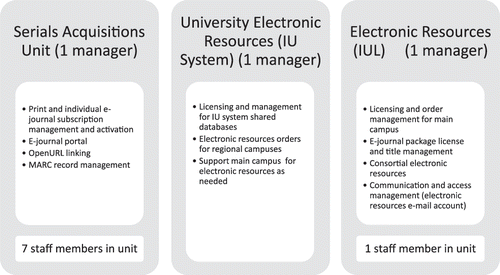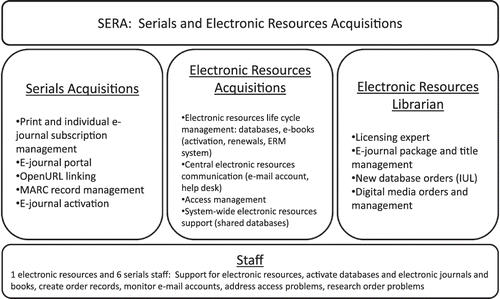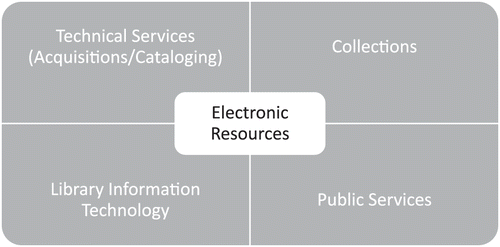Abstract
In this session, Lynda Fuller Clendenning and Lori Duggan presented information about a recent reorganization at Indiana University Bloomington Libraries that pulled together serials acquisitions staff and electronic resources library staff into a single unit. They discussed the impetus for the reorganization, the recommendations of a consultant hired to analyze the workflow, and the transition from a silo model toward one involving more cross-training. They also covered the skill set required to work with electronic resources, the relationship and coordination with all areas of the library (technical services, collections, information technology, and public services), some details of the new workflow, and some future issues under consideration.
INTRODUCTION
Lynda Fuller Clendenning and Lori Duggan of Indiana University (IU) Bloomington Libraries began their presentation about their recent electronic resources unit reorganization with some background information on their university. IU Bloomington has 38,990 students, including 8,596 graduate students. It is the flagship of the eight IU campuses, which have a combined total of nearly 100,000 students.
IU Bloomington Libraries, including the Herman B. Wells Library and thirteen branch libraries, are classified as research libraries. With an $11 million dollar collection budget, the library manages over five hundred databases, as well as more than thirty thousand e-journals and five hundred thousand e-books, including IU shared electronic resources. Prior to the reorganization, the acquisitions staff of thirty was divided into seven separate units: serials (ordering and receiving), electronic resource acquisitions, university electronic resource acquisitions, monographs ordering, monographs receiving, accounting, and gifts.
MOTIVATION FOR CHANGE
Under the silo model shown in , the question of who does what in the electronic resource workflow was always coming up, even internally, and was not good for customer service. Different units created orders in different ways, leading to more confusion. These workflow inefficiencies were a primary motivation to change the organizational structure.
In addition, the library felt that they must prepare for the future, specifically the shift from print to electronic resources. The workload for electronic resources was increasing (over 50 percent of their budget is now spent on electronic resources), so there was a need to put more staff resources in that area. They wanted to focus on supporting their users, who primarily desire online resources. Since users are increasingly finding library resources via Google and other Web-scale services, they felt a need to expose their products there accordingly, and to devote more staff time to that type of work. They wanted better coordination of electronic resource activities in order to achieve more consistency, to reduce duplication of work, and, in particular, to make licensing more efficient. This type of work requires technical services staff with a range of knowledge and understanding, not just of one procedure. In addition to understanding the entire internal workflow of a resource, these staff members need a broad view that takes into account what is happening with consortial resources, and they need the capability to take more responsibility for making decisions.
CONSULTANT RECOMMENDATIONS
The library hired R2 Consulting in 2007 to analyze staffing levels and workflows and develop recommendations for changes. The report, provided in fall 2007, recommended that the library purchase and implement an electronic resource management (ERM) system, consolidate core electronic resource responsibilities into a single group, and create a combined serials and electronic resources acquisitions unit. The recommendations were incorporated into the reorganization and implemented by July 2008.
NEW UNIT STRUCTURE
The new combined unit, called Serials and Electronic Resources Acquisitions, or SERA, includes one electronic resource and six serials staff who report to the Head of Electronic Resources and the Head of Serials, respectively (). The staff members in each of the two units have expanded their purview under the SERA umbrella to perform duties in each of three units included in SERA.
This has involved an expansion in the skill sets of all of the staff members. By upgrading some staff positions, the library now indicates the following skill sets as preferred for staff working with electronic resources: computer file management skills such as exporting and importing; spreadsheet skills involving retrieval, formatting, display, and analysis of data; communication skills; problem-solving skills such as solving puzzles and asking questions (staff can no longer expect to be told what to do step-by-step); and soft skills beyond specific task performance such as creativity, problem spotting, anticipation of the result of actions, and the ability to produce a report from specific data.
COORDINATION AND ADMINISTRATION
The work involved in electronic resource management necessarily intersects with all areas of the library (). Catalogers in Technical Services deal with title changes and treatment of new formats. Collections staff handle new orders, renewals, and issues with existing databases. Information Technology (IT) staff handle access issues, implementation, and a myriad of other issues. Public services staff members are often the first to notice access problems.
Because of this, the SERA administration team (the Head of Serials, the Head of Acquisitions, and the E-Resources Librarian) works closely with representatives from other parts of the library in a structured way. They have weekly internal planning meetings, monthly meetings with the Associate Dean for Collection Development, and monthly meetings with Collection Development and Public Services. IT staff will attend as necessary. The goal is to make people and units interoperable.
DEVELOPING A NEW APPROACH
As a result of this restructuring, many processes have been streamlined. In the past, database renewals were tracked individually on a spreadsheet. Now they use the integrated library system (ILS) for this. They worked hard to automate the workflow and eliminate shadow systems (tasks that may have been tracked individually but that were already in the ILS).
Day-to-day access issues have been streamlined by adding additional staff coverage to a shared e-mail account to which database and e‐journal problems are reported. This is called the “help desk.” All SERA staff work the help desk in shifts, applying standard categories to each e-mail. They all have the knowledge to solve electronic access problems reported to the help desk, even those who primarily work with print. For the most part, staff members have responded well to these new challenges.
LOOKING TO THE FUTURE
Finding new guidelines for solving electronic access issues is an ongoing process because they are not routine and they require different skill sets (for example, browser issues and wireless connection problems). The unit plans to develop a wiki for creating a searchable record of access problems that have been encountered. They also hope to further streamline e-book processes, as single title e-book orders have increased exponentially over the last year. By mid-summer 2009, they plan to implement an ERM system and are looking forward to the bells and whistles and wondering how they are going to make it work for them.
They anticipate further staffing issues. While cross-training and repurposing staff, getting them to break out of the “silo mentality” is an ongoing challenge. Additionally, given the economic situation, there is an uncertain staffing climate and universal worry regarding staffing levels. They currently have three frozen staff positions.
They also foresee new roles and additional opportunities for collaboration. They hope to support ingest activities in IU Scholarworks, their institutional repository. Perhaps acquisitions staff could acquire pre- and post-publications by faculty. It is possible the institutional repository will become an archival mechanism for conferences held at the university and the SERA staff could manage these records. They could play a role in supporting copyright clearance work for the Committee on Institutional Cooperation shared repository by checking the copyright clearance status of documents in the repository. They could process streaming media and add it to the portal. They will need to adapt to new digital formats, including flash drives, e-book readers, and mobile devices.
They have been working under the new organizational structure for a year and it is going well. Staff members are sharing ideas and are open to new ideas. The whole group is focused on the future.
QUESTION AND ANSWER SESSION
During the question and answer session, the presenters were asked to elaborate on why the staff responded so well. Clendenning responded that, “change isn't easy and this change was gradual enough to make it easier.” It was communicated well and was based on external consultant recommendations. Nothing drastic happened, so staff fears were lessened. Staff members had ample opportunities to give ideas and have played a role in the changes. They talked about it a long time before any changes were made and they have found that cross-training helps a lot.
Regarding the type of training program implemented, the presenters indicated that staff are encouraged to take university-provided Excel (and other) training sessions. They did not formally track the number of training hours involved in the reorganization.
There were a number of questions about the need for new job descriptions, position announcements, and so on. Because they have changed a number of processes (for example, no more claiming and binding as is), job descriptions have been changed. For major players in SERA and for any positions that were upgraded, they re-wrote the job descriptions. Job announcements were re-written to include specific skills such as Excel. According to Clendenning, it was trickier to require soft skills such as problem solving and creativity. Regarding finding staff who have these soft skills, she highlighted the fact that they “have been most successful in bringing people up through the ranks, especially those in library school.” They feel very lucky to have a local library school.
When asked about the role of the IT department and, specifically, why SERA deals with browser and similar issues, the presenters clarified that it is because the shared e-mail help desk is the mechanism for reporting problems. SERA staff are asked to address the problems that they know how to handle, but to get help from IT if problems beyond reach are encountered. Their IT department does handle proxy server activities as well as bulk record imports from Serials Solutions. In acquisitions they do rapid cataloging for titles with records created by the Library of Congress. They are working on alternative schema. They also use Promptcat.
The presenters were asked to elaborate on the experience with the consulting firm. The purpose was to review technical services operations. It was a four-day process that involved interviews with 150 people. They specifically wanted to see if they could find ways to streamline. They looked at exception-based processing and finding ways to reduce exceptions (for example, having different workflows for other libraries/branches).
Finally, they were asked whether the additional meetings of the SERA administrative group have taken too much time. According to Duggan, they never meet more than an hour and if there are no issues to discuss, they do not meet. Clendenning closed by summarizing that, “going out and trying to find a problem is not something we can afford to do.”
SELECTED BIBLIOGRAPHY ON ELECTRONIC RESOURCES STAFFING
Albitz, Rebecca S., and Wendy Allen Shelburbe. “Marian Through the Looking Glass: The Unique Evolution of the Electronic Resources (ER) Librarian Position.” Collection Management 32, no. 1/2 (January 2007): 15–30, doi:10.1300/J105v32n01-03 | |||||
Campbell, Jerry D. “Changing a Cultural Icon: The Academic Library as a Virtual Destination.” Educause Review 41, no. 1 (January 2006): 16–30. | |||||
Cohn, John M., and Ann L. Kelsey. Staffing the Modern Library: A How-To-Do-It-Manual. New York: Neal-Schuman Publishers, 2005. | |||||
Dollar, Daniel M., et al. “Realizing What's Essential: A Case Study on Integrating Electronic Journal Management into a Print-Centric Technical Services Department.” Journal of the Medical Library Association 95, no. 2 (April 2007): 147–155, doi:10.3163/1536-5050.95.2.147. | |||||
Duranceau, Ellen Finnie, and Cindy Hepfer. “Staffing for Electronic Resource Management: The Results of a Survey.” Serials Review 28, no. 4 (December 2002): 316–320, doi:10.1016/S0098-7913(02)00224-1. | |||||
Montgomery, Carol Hansen. “Measuring the Impact of an Electronic Journal Collection on Library Costs: A Framework and Preliminary Observations.” D-Lib Magazine 6, no. 10 (October 2000). http://www.dlib.org/dlib/october00/montgomery/10montgomery.html (accessed July 17, 2009). | |||||
Montgomery, Carol Hansen, and Donald W. King. “Comparing Library and User Related Costs of Print and Electronic Journal Collections.” D-Lib Magazine 8, no. 10 (October 2002). http://www.dlib.org/dlib/october02/montgomery/10montgomery.html(accessed July 17, 2009). | |||||
Sennyey, Pongracz, Lyman Ross, and Caroline Mills. “Exploring the Future of Academic Libraries: A Definitional Approach.” Journal of Academic Librarianship 35, no. 3 (May 2009): 252–259, doi:10.1016/j.acalib. 2009.03.003. | |||||
Zhang, Xiaoyin, and Michaelyn Haslam. “Movement toward a Predominantly Electronic Journal Collection.” Library Hi Tech 23, no. 1 (February 2005): 82–89, doi:10.1108/07378830510586720. | |||||


